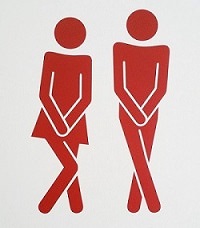

Incontinence is a bladder control condition that nobody likes to talk about. This embarrassing problem is more widespread than you think and is simply the result of an overused muscle getting a bit rusty. The good news is that there are plenty of treatments. It’s more likely to happen as you age, and the condition is twice as likely to affect women. Sometimes it’s onset by other medical conditions. Whatever the case, if you’re suddenly leaking, go get diagnosed by a doctor. |
||
|
There are two main types of incontinence. Stress incontinence is when pressure is placed on the bladder. Urine might leak when you laugh, cough, sneeze or during any activity that is straining your bladder. In women, this can be caused by pregnancy, a hysterectomy, or anything that stretches the pelvic floor muscles. In men, this happens when the prostate gland is removed, and the sphincter, a ring-like muscle that closes bodily openings, is the only muscle keeping the urine in the bladder. Urge incontinence is when you suddenly need to urinate, and can’t reach the bathroom in time, caused by an overactive bladder that pushes urine out the bladder suddenly. Doctors have found it might be due to bladder irritation, emotional stress, or other brain conditions such as strokes or Parkinson’s disease. Men can also suffer from overflow incontinence, the sudden need to urinate, followed by only a trickle. The urine that remains in the bladder will leak later. Something blocking the urethra usually causes this. The other kind of incontinence to plague men is total incontinence, which is when the sphincter stops working and urine leaks constantly.
|
||
|
Treatment & Care There are many different cures available and the one you use will depend on your lifestyle, the type of incontinence and the severity of the condition. Some people can treat it with some basic lifestyle changes while others will need to take medication. There are also several behavior therapies that are effective. More severe sufferers might need to consider surgery. |
||
|
Behavioral therapies There are also several behavioral therapies that can used to help with incontinence. Bladder retraining is used to help with urge incontinence. With this therapy, you learn how to control your bladder muscles by prolonging the time you wait between going to the toilet. It is often used along with scheduled urination and double voiding (a technique where you urinate twice, with a scheduled break in between). Another well-known therapy is pelvic floor exercises, popularly known as "kegels". This is a stretching exercise that focuses on making your pelvic floor muscles stronger, since these muscles control your urine flow, and ensure your pelvic organs rest in the right place. It is used for both stress and urge incontinence. This technique involves identifying the muscles used to hold urine in and intermittently squeezing and relaxing them. They can be done without any equipment or supervision. Similarly some women also use vaginal weights, coned shaped tampon sized weights, to help with their pelvic floor muscles. This is used in conjunction with another therapy called biofeedback. It’s a practice supervised by a trained therapist, whereby you learn to control your bladder by reading your body’s signals. |
||
|
Surgery
|
||
| Source | ||
|
Lifestyle changes Sometimes it takes some time to cure incontinence and often with older people, surgery might not be an option. Fortunately, there are many management techniques available. Some people take to wearing products such as absorbent underwear, incontinent clamps, and adult diapers. Others keep bed pans and urinals close-by. More severe male sufferers might consider catheters. Diuretics, medication used to treat some heart, liver and kidney diseases are designed to make your bladder work more. If there are alternative medicines available, speak to your physician about this. |
||
|
Changes to your diet can also help as some foods and medications aggravate the bladder. Alcohol is a no-no because it interferes with signals to the brain that tell your body to urinate. Similarly caffeine, carbonated sodas and sparkling waters also stimulate the bladder to produce more urine, causing a few more visits to the bathroom than necessary. Nicotine, the key ingredient in cigarettes, is another bladder aggravator. Smoking may induce coughing, which can intensify stress incontinence. Here are some tips on how to quit. Doctors also advice weight loss, as excess weight can aggravate bladder muscles. Finally, there are some foods, especially acidic ones, which irritate the bladder. Cutting down on citrus, tomatoes, vinegars, dairy products, chocolate, sweeteners, spicy foods, and aged cheeses have been found to help. |
||